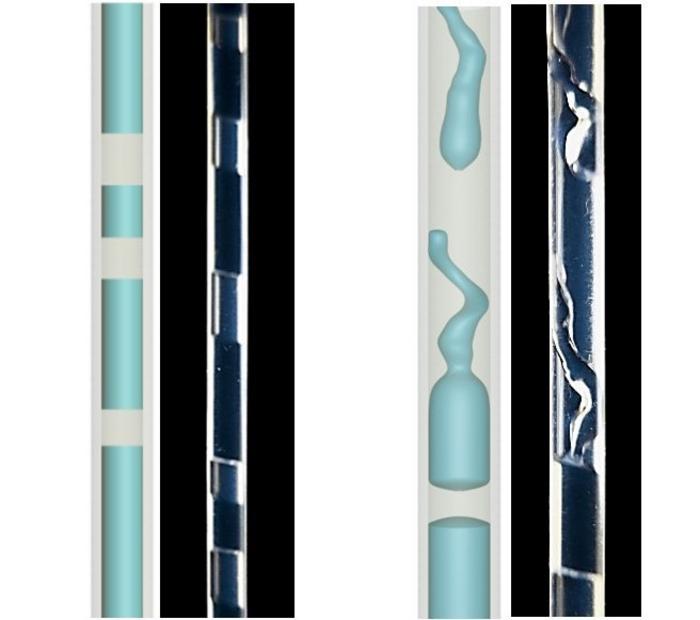In a groundbreaking advancement that could reshape the future of renewable energy, scientists have successfully demonstrated a novel method to generate electricity using the natural movement of water droplets inside a polymer tube. This pioneering technique exploits a unique flow pattern known as “plug flow” to convert the mechanical energy of falling rainwater into usable electrical power, breaking through limitations that have long restricted the efficiency of water-based energy harvesting systems.
The fundamental principle at play is triboelectricity—an electric charge generated when two different materials come into contact and subsequently separate. Most people are familiar with this phenomenon as the static electricity created when rubbing a balloon against hair. Similarly, when water interacts with certain surfaces, it can gain or lose electrical charge. Historically, attempts to utilize flowing water to produce electricity have focused on continuous streams moving over conductive surfaces. Yet these systems have suffered from poor efficiency because the charge separation only occurs at the interface and is limited by the so-called Debye length—a minuscule distance over which electrostatic interactions are effective.
Researchers led by Siowling Soh from the National University of Singapore have now overturned this conventional limitation by harnessing the properties of plug flow within a larger-scale tubular system. The setup involves a vertical polymer-coated tube, approximately 32 centimeters tall with a narrow diameter of 2 millimeters, which channels discrete plugs of water separated by small air pockets. These plugs are generated by injecting raindrop-sized droplets into the tube, which collide and merge at the top before descending under gravity.
Unlike steady continuous flow, this plug flow pattern fundamentally alters the dynamics at the water-surface interface. As each plug moves downwards, it behaves like a distinct entity, creating repeated and intensified charge separations. The presence of air pockets between these plugs prevents continuous charge neutralization, allowing the electrical potential to accumulate significantly over time. This inventive approach allows effective charge generation beyond the constraints of the Debye length, marking a paradigm shift in the field.
To quantify the energy that could be harvested, the team attached electrodes at both the top and bottom collection points of the tube to capture the electric current generated by the flowing plugs. Remarkably, this system converted more than 10% of the water’s gravitational potential energy into electrical energy—a conversion efficiency orders of magnitude higher than prior continuous flow devices. Comparatively, plug flow generated electricity at a rate almost 100,000 times greater than its continuous stream counterpart, demonstrating its extraordinary potential.
Furthermore, the research extended these initial findings by scaling the mechanism. Channels incorporating multiple tubes—two or even four arranged sequentially—achieved multiplicative effects in energy generation. In a striking demonstration, the configuration powered a dozen LEDs continuously for 20 seconds, underscoring the feasibility of this technology for practical applications. This modular scalability hints at future devices capable of harvesting meaningful amounts of electricity from natural rainfall in urban or remote settings.
This technology presents a compelling alternative to traditional hydroelectric power plants, which rely on massive water flows through dams or turbines and require specific geographic features such as rivers or steep elevation drops. In contrast, the plug flow system could be implemented on rooftops, building facades, or other infrastructures where rainwater naturally collects or flows, providing a decentralized and accessible green energy solution.
Moreover, the simplicity and robustness of the apparatus are advantageous for maintenance and deployment. The core component—a polymer tube coated with a thin metallic layer—can be manufactured at low cost and integrated easily with existing water harvesting systems. The mechanism also circumvents the need for expensive and energy-demanding microfluidic pumps, relying instead on gravity and the natural size distribution of raindrops.
Scientifically, this discovery challenges the prior understanding of electrokinetic energy harvesting by breaking through the Debye length barrier, which was once considered a fundamental efficiency bottleneck. The key insight is that by shifting from a continuous flow to a discrete plug flow regime, charge accumulation can be dramatically enhanced by engineering the hydrodynamics and interfacial properties of the system.
The implications extend beyond rainwater energy harvesting. The principles demonstrated here could inspire novel designs in microfluidics, sensor technology, and other domains where charge separation and flow manipulation are critical. Additionally, embracing plug flow mechanisms may unlock new frontiers in sustainable energy technologies, harnessing abundant natural phenomena through elegant scientific innovation.
Importantly, the research also contributes to the broader landscape of clean energy development at a time when the urgency to reduce carbon emissions and shift to renewable sources is paramount. By harvesting energy from falling rainwater—a freely available, constant, and underutilized resource—this work aligns with global sustainability goals and opens pathways to decentralized, low-impact power generation.
While further engineering refinement and field testing are essential, early results point toward promising scalability and integration potential. The collaboration between fundamental science and applied engineering embodied in this study exemplifies how interdisciplinary efforts can chart new courses in energy innovation.
In sum, this breakthrough in generating electricity from falling rainwater via plug flow represents a milestone achievement, blending insightful physical chemistry with practical engineering to yield a renewable energy technology poised to make a significant environmental and societal impact.
Subject of Research: Renewable electricity generation through water-induced charge separation and plug flow dynamics
Article Title: Plug Flow: Generating Renewable Electricity with Water from Nature by Breaking the Limit of Debye Length
News Publication Date: 16-Apr-2025
Web References: DOI: 10.1021/acscentsci.4c02110
Image Credits: Adapted from ACS Central Science 2025, DOI: 10.1021/acscentsci.4c02110
Keywords
Chemistry, Sustainability, Green energy




